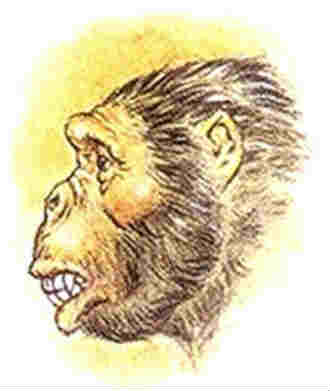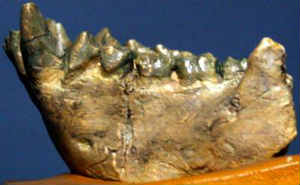|
|
EUGENE M. MCCARTHY, PHD
Dryopithecines

 Dryopithecine mandible found by Lartet (Enlarge image) Muséum national d'Histoire naturelle. Image: Wikimedia
Dryopithecine mandible found by Lartet (Enlarge image) Muséum national d'Histoire naturelle. Image: Wikimedia(/"DRĪ-ō-PITH-ə-seenz"/)
Old World anthropoid apes known from fossils of Miocene and Pliocene age. They were first named by the French paleontologist Éduoard Lartet, who in 1856 described the remains of an ape he had found in Miocene strata at Saint-Gaudens in the Haute Garonne department of southern France. The find consisted of a portion of a lower jaw with teeth (see figure, below left), and the shaft of a humerus. They are now thought to have existed from 12 to 9 mya.
These apes, which were generally similar to modern chimpanzees and gorillas, were forest dwellers. Because the remains of oaks were common in the lignite beds in which the first specimen was found, Lartet assigned this creature the generic name Dryopithecus ("oak-forest ape" in Greek). Unlike the extinct giant ape Gigantopithecus, which is usually classified in the same subfamily as orangutans (Ponginae), dryopithecines are generally grouped with humans, chimpanzees, and gorillas in subfamily Homininae.
In the years since, the remains of dryopithecines have been recovered from additional sites as widely dispersed as northeastern Spain (Catalonia), Hungary, and China. Proconsul and Kenyapithecus are two dryopithecine primates from the Miocene of eastern equatorial Africa. An additional Miocene form, Ramapithecus, is known from northern India.
In life, although there was a certain amount of variation in body size, a typical adult dryopithecine appears to have weighed about 35 kg (~77 lbs) and had the same dental formula as do modern apes and human beings (2:1:2:3 in both jaws). The thin tooth enamel indicates a probable diet of leaves and fruit. The structure of the shoulder joint suggests these animals used their hands, as well as their feet, in locomotion.
References:
Kordos, L., Begun, D. R. 2001. A new cranium of Dryopithecus from Rudabanya, Hungary, Journal of Human Evolution, 41: 689-700.
Lartet, E. 1856. Note sur un grand singe fossile qui se rattache au groupe des singes supérieurs. C. R. Acad. Sci. (Paris) 43: 219-223.
Harrison, T., et al. 1996. A reinterpretation of the taxonomy of Dryopithecus from Vallés-Penedés, Catalonia (Spain), Journal of Human Evolution, 31: 129-141.
Xue, X., Delson, E. 1989. A new species of Dryopithecus from Gansu, China, Chinese Science Bulletin 34: 223-230.
Most shared on Macroevolution.net:
Human Origins: Are we hybrids?
On the Origins of New Forms of Life
Mammalian Hybrids
Cat-rabbit Hybrids: Fact or fiction?
Famous Biologists
Dog-cow Hybrids
Georges Cuvier: A Biography
Prothero: A Rebuttal
Branches of Biology
Dog-fox Hybrids